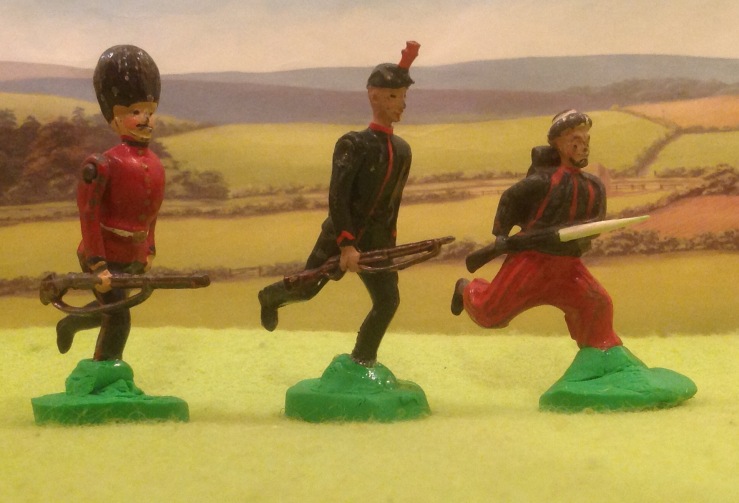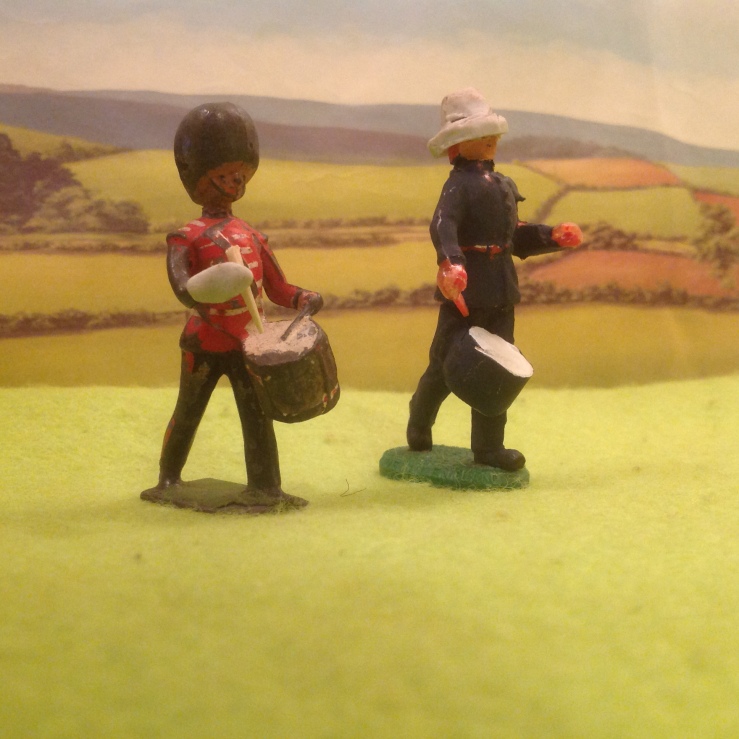There are old soldiers and there are bold soldiers, but there are no old, bold soldiers, as the saying goes.
I always feel a bit sad seeing the lead graveyard of damaged toy soldiers that is sometimes EBay.
Repairing horses or cavalry is very tricky. Infantry are less tricky, if you are not too fussy, although many companies like Dorset Soldiers will do a fine job for you but at a cost. Recast heads and arms are available from several companies.
There is surprisingly little information on the Internet about repairing old broken lead soldiers.
I have been working my way through some of the casualties that have turned up in job lots of vintage toy soldiers to give them some gaming life again. I’m not one for a soldering iron or even Milliput / Green Stuff. This is not family friendly for us to use in our house as we have allergies to this Green Stuff in the family.
What else could I use to repair these damaged warriors?

What puts toy soldiers literally back on their feet in our house is Fimo or Sculpy polymer clay.
Crude, but using the traditional matchstick or cocktail stick into the hollow of the damaged legs, it is possible to make a custom made ‘prosthetic’ Fimo base to support the balance or weight of the damaged figure.
30 minutes baking later and once cool, the figure can be glued back into position on its Fimo base. Two pence pieces make good weighty support bases.

Overly chunky Fimo supports can be disguised if flocked or Fimo / Sculpy remains slightly shaveable with a scalpel after baking.
Once these bases are painted and the feet painted in, they should look slightly less clumsy but at least they are sturdy and live to fight again! With a few new arms bought in and a bit of repainting where needed, they should look almost shiny and new, certainly enough for the odd tabletop or garden skirmish.

Cocktail sticks cut and shaved into shape make good simple repairs for broken rifles, once glued into place and painted.

Some of the natives in this batch needed extensive rearming, new shields and rebasing with new feet.

These natives are part of a slowly growing force of natives, one I have repainted from bashed and damaged Zulu figures in job lots, ready for skirmish gaming.

One or two figures still need to have Fimo hands added like this Grenade thrower or hands / gloves shaved down into size like this drummer boy.

Sometimes the balance of figures is not quite right, as in the charging Tommy in the steel hat. One to rebase again!

Really pleased to have found a simple method of repairing of rebasing damaged figures. I will post some updated figures when these damaged figures are repainted or finished.
Posted by Mark, Man of TIN blog, 18 November 2016.

If you want to strip paint off old lead (or plastic) figures but don’t want too use chemical paint stripper you can soak them overnight in a jar of Dettol pine disinfectant and next day the paint cleans off easily with a drop of detergent on an old toothbrush. You probably know this already but I thought I’d mention it for anyone who else who didn’t. It’s a lot less messy and smelly than paint stripper like Nitromors and does a better job on small items but it’s still powerful stuff and you need to be careful with it around young children and cats.
LikeLike
Thanks for this tip, Brian! I didn’t know this tip and I’m sure that this disinfectant is more accessible stuff in your average household than other products. As ever it’s a chemical so I’ll check the COSHH label etc.
Thanks
Mark Man of TIN blog
LikeLike
It is great to see you helping our lead companions to have fallen upon hard times. Everyone deserves another battle,another parade.
Alan
LikeLike
Alan
I do feel genuinely sad to see somebody’s once pride and joy so bashed, although happy that once they had a play life and even happier to bring them back to life again. Saved from the lead graveyard or the scrapyard.
I’m sure their little hearts of TIN are thankful and racing to get into action!
For some people it’s rescuing greyhounds, factory chickens, preserved steam engines etc, for me it’s bashed toy soldiers. Some slightly misplaced empathy here!
I have to be wary of storage issues though – The Fimo and cocktail stick repair method is so simple, it’s tempting to buy too much scrapyard stuff. As they, like repaints, have little or no value, you can do whatever you want with them without affecting collectors value.
Mark, Man of TIN blog
LikeLike
(2nd try at leaving a comment)
Good work on the repairs! I also like broken figures as a source of bodies and/or parts for conversions.
Have you tested alternative putties that harden without baking? Things like milliput which disolves in water prior to hardening, or acrylic wood putty etc? Not to mention Ye olde plasticine and banana oil! One of those might be less allergy unfriendly than green stuff.
LikeLike
Ross
Thanks for the suggested range of alternatives – I shall look into them.
Never tried ye olde banana oil and plasticine combination, that’s pure Donald Featherstone!
Mark, Man of TIN blog
LikeLike
In Soviet book “Toy soldiers & Toy Ships” described a few methods of repairing toy soldiers. For example, if you want to repair a base, you can put a soldier in a mould and simply cast the base. The metal needs to be heat up stronger so that the soldier can fuse with base. For guns you can solder a sutable part of lead or tin in apropriate shape.
LikeLike
An interesting method, one that I have not yet used or tried. My soldiering is pretty useless, I usually melt everything!
Thanks for your comment and for posting the 1989 Toy Soldier book on Little Wars Revisited 54mm forum. This is a charming and very attractively illustrated book. It reminds me a little of H.G. Wells’ Little Wars
and of Alfred Lubran’s 1940s Wartime games book On my blog post https://manoftinblog.wordpress.com/tag/alfred-lubran/
LikeLike
You’re welcome! The Rurik Popov, who’s was an artist for this book, was an author of this game. He was playing an imaginary country – Illyria, which he got from he’s father Boris. It’s all started in St.-Petersburg, in 1913, when three children of an lawyer, Boris, Shura and Vella, created their own countries – Illyria, Shungia and Vellia. They built cities and populated with tin civilians. And waged wars, of course.
LikeLike
Interesting. They are charming illustrations.
This trio of children Boris Shura and Vella Popov and their own countries based on their names – Illyria name exists in Shakespeare – sounds a little like the ImagiNations countries and battles of the Bronte Sisters (and Brother) up in Yorkshire (Northern England) back in the 1820s /30s as children before they wrote their famous novels as adults. Inspired by a box of wooden toy soldiers by their parson / vicar father, their juvenile fictions of GlassTown Angria and Gondal set in the period of Napoleonic and early 1800s are often seen as the first RPG Role Playing Games
More on my page / posts here:
https://manoftinblog.wordpress.com/gaming-the-bronte-family-imaginations-of-glasstown-angria-gondal-and-gaaldine/
The date 1913 in your comment suggests that a copy or pictures from famous novelist H G Wells Floor Games 1911 or Little Wars 1913 might have made it to St Petersburg. Not so unlikely? Wells was a world famous science fiction writer and novelist on the edge of the socialist movement in Britain with many international friends.
https://manoftinblog.wordpress.com/h-g-wells-little-wars-floor-games-toy-theatres-and-magic-cities/
H G Wells’ Little Wars 1913 is worth looking at just for the line drawings and photos – scanned copy here
https://archive.org/details/littlewarsgamefo00well
And Floor Games 1911
https://archive.org/details/floorgames00well
It would be interesting to know how Boris, Shura and Vella (and later Rurik Popov) and their tin Toy Soldiers Worlds survived during the upheavals of revolutions and world wars.
LikeLike